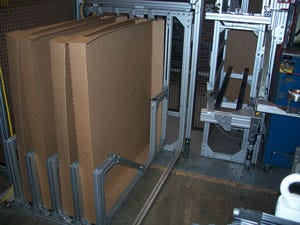An intelligent (and job-saving) approach to automation
Investing in appropriate technology for its automotive customers gave one Midwest molder a cycle-time and cost-cutting edge.
March 3, 2010
Investing in appropriate technology for its automotive customers gave one Midwest molder a cycle-time and cost-cutting edge.
Employing robots to automate repetitive machine-tending tasks is nothing new to manufacturing, nor is the notion that the main reason for doing it is to reduce labor costs. But for contract manufacturer and molder Nyloncraft Inc. (Mishawaka, IN), automating enabled the company to add labor in key areas where it was needed to support growth, without having to hire new employees. This strategy was part of the company's recent push to reduce labor costs, says Nyloncraft automation engineer Carl Smith.
|
A Motoman UP50 high-speed material handling robot palletizes injection molded air-cushion-ride pistons in one of three production cells automated by Tier One automotive supplier Nyloncraft. |
|
A custom-designed aluminum rack in each of the three piston-molding and palletizing cells solved the cardboard-storage challenge. Each rack holds four pieces of folded cardboard, which have to be placed in a specific orientation to allow the robot to pick them up using a suction-cup EOAT and then place each piece onto the pallet. |
|
In one of two cells making large end-gate covers and spoilers for full-size pickup trucks, the entire cycle is completed in 1 minute, partly attributed to an automated gate-cutting operation. |
"Adding robots to our injection molding cells has been a focus for the last five years, and has significantly reduced our costs and improved flexibility in the shop," says Smith. "We've been able to bring in more work due to the efficiency gains from the robots, and we've reassigned machine operators to other critical tasks, such as assembly."
When Smith joined the company in 2004, he had spent the previous four years helping another molder apply automation to its shop. Since then, Nyloncraft has integrated several material handling, machine-tending robots onto its shop floor. The automation investment was part of a $10 million expansion of the company's thermoplastic molding operations, originally planned in January 2004. The firm is a Tier One, ISO/TS 16949- and ISO 14001-certified supplier to the automotive industry, with injection molding machines to 3000 tons, including dual-shot presses from 1500-3000 tons, in its 165,000-ft2 plant.
A leadoff home run
Smith hit the ground at a sprint after joining Nyloncraft, immediately canceling a robot order that had been placed prior to his arrival, and specifying a different robot better suited to the task required.
"With this initial automation project targeted back in 2004, I knew it had to work perfectly and get up to speed quickly and painlessly," Smith recalls. "Otherwise, management and the workers in the shop might have lost confidence in the ability of robots to work in this environment. I've learned that when trying to introduce automation onto the factory floor, the first try has to be successful to get buy-in for future automation projects."
That first try for Smith involved automating three injection molding workcells by placing robots in the center of each cell to remove parts from the machines, facilitate value-added operations such as drilling and component insertion, and then palletize the parts. The three cells incorporate 700-ton Cincinnati Milacron machines, which produce air-cushion-ride pistons. Prior to automation, each cell required its own operator to drill, inspect, and palletize the parts; now, one operator tends to all three cells, checking and replenishing them with material, including inserts and cardboard separators for palletizing. Fully stocked, each cell can run for 2 hours.
"The robots initially specified for these cells were to be mounted above the injection molding machines and reach down into the mold to remove the parts," says Smith. "Installation would have required us to make stands for the robots and build a mezzanine to allow the robots to reach the drilling operations, which created a safety concern. Instead, I went with a floor-mounted robot that can come in from the back side of the machine to remove the parts from the mold-a much safer solution and simpler to integrate. The switch saved the company about $25,000 per robot."
Eight part models, three cells
Now, each of the three cells, which measure 10 by 12 ft, features a six-axis Motoman UP50 robot with 50-kg payload, and an Applied Robotics CXC30 tool changer that enables quick and automatic switching of end-of-arm tooling (EOAT). Through the use of tool stands and programming, the three cells combined can produce eight different piston models with minimal changeover time.
The robots are high-speed models designed by Motoman with a streamlined body that helped Smith optimize cell layout. They move molded parts from the presses through a series of tasks within the cell. Robot speed peaks at 250°/sec in some axes and 170°/sec in other axes. Maximum payload is 50 kg; reach is 3.6m vertically and 2m horizontally, with repeatability of ±0.07 mm.
The pistons made are 8-10 inches in diameter and 6-10 inches tall, and weigh 3-4 lb. They replace aluminum air-rise suspension components, providing a 33% cost reduction and 25% weight reduction, according to Nyloncraft.
Some of the molded pistons require a mechanical sprue-cutoff operation, some require a drilling operation, and some have inserts added. Every part moves to a visual inspection station, where a Keyence CV700 system checks for holes, inserts, and proper part identification. Average cycle time: 70 seconds.
Automating the sprue-cutoff operation posed a unique challenge to Smith and his team. "We developed a special setup to mimic the actions our operators had been using to snap off the sprues manually," says Smith. Sprues measure 6 inches long and taper from a 3⁄8-inch diameter down to a point. Using the new custom-designed cutoff device, the robot places the part into the hole-off center-of a cone-shaped fixture. Then, a cylinder underneath the cone rotates the fixture and the action from the offset hole snaps off the sprue.
Automated palletizing
Parts that pass inspection move via robot to a two-tiered conveyor system for palletizing; parts that fail inspection move to an outgoing parts chute. The robot also places a prefolded cardboard separator at the start of each pallet and between each layer of parts; the cardboard pieces have a 3-inch folded edge to contain the pistons. Pallets hold as many as 250 parts and eight layers.
"One of the initial challenges with these cells was how to stage the folded cardboard pieces within the cells so that the robots could grab them. Also, the folded edge on the cardboard pieces created interference with the wiring harnesses from the EOAT as the robots placed the parts on the pallet, another hurdle for us to clear," says Smith. He solved the interference problem by creatively programming the robots and redesigning the gripper to extend its reach.
An aluminum custom-designed storage rack in each cell solved the cardboard-staging challenge. "Each rack holds four pieces of folded cardboard, which have to be placed in a specific orientation to allow the robot to pick them up using a suction-cup EOAT and place them on the pallet," says Smith. Since each layer fills up in about 30 minutes, the four cardboard separators allow the cell to run untended for a 2-hour cycle.
In addition to light curtains that guard the palletizing conveyors, operator safety is ensured by integrated zone rings designed into each robot. As each robot turns on its base plate, limit switches sense its position and send permit signals to the cell control, which communicates with an array of access gates within each cell. For example, the zone ring prevents the robot from entering the area where the cardboard racks are located while the operator is restocking cardboard in that gated area of the cell.
Up next: Handling large parts
After automating the three palletizing cells, in mid-2006 Smith turned his sights toward automating a pair of new injection molding cells that produce large end-gate covers and spoilers for full-size pickup trucks. One cell features a 1500-ton Cincinnati Milacron press, the second a 1750-ton Engel press; both include Motoman HP165-100 robots with NX100 controls, and an Applied Robotics MXC160 tool changer that enables the cells to adapt quickly to manufacturing either the spoilers or the covers. Parts are 3.5-4 ft long and weigh 2-3 lb; EOAT with vacuum cups and grippers stabilizes the parts during transfer.
Nyloncraft chose the high-speed HP165-100 robot for its extended work envelope, 100-kg payload, 4.1m vertical reach, 3.0m horizontal reach, repeatability of ±0.2 mm, and NX100 control that features a Windows CE programming pendant, fast processing, and a robust PC-based architecture.
"In these cells, we needed to automate and produce two finished parts with a 1-minute total cycle time-a difficult challenge considering we're running two-cavity tools," Smith says. "The key was developing an automated process to cut off the gates. We initially outfitted each cell with a router to cut off the gates, which not only made a mess, spraying chips all over, but also required a part-flipping operation. Cutting the gates off of both molded parts required the robot to wait 15-20 seconds for both parts to be cut. We redesigned the operation to reduce the cutoff process down to 8 seconds total, from the time the robot grabs the parts from the mold to cutoff."
Now, after the robot carries the parts from the mold to a fixture, the new gate-cutoff process uses a set of rollers mounted to a trolley that rides over the fixtured parts. As the trolley moves, the rollers apply pressure to the top and sides of each part and a knife cuts the gates from the part. The Nyloncraft toolroom developed the cutter.
"We had to do a lot of development work to guarantee that the parts locate precisely in the fixture during each cycle," stresses Smith, "and that the mold and ejectors are in the same position for each cycle. This ensures that the robot accurately locates the parts in the cutoff fixture and also accurately controls the amount of pressure applied to grab the parts. Too much pressure and we would mar the part." Average cycle time has been refined to just 50 seconds, nicely surpassing the 1-minute goal.—[email protected]
About the Author(s)
You May Also Like





